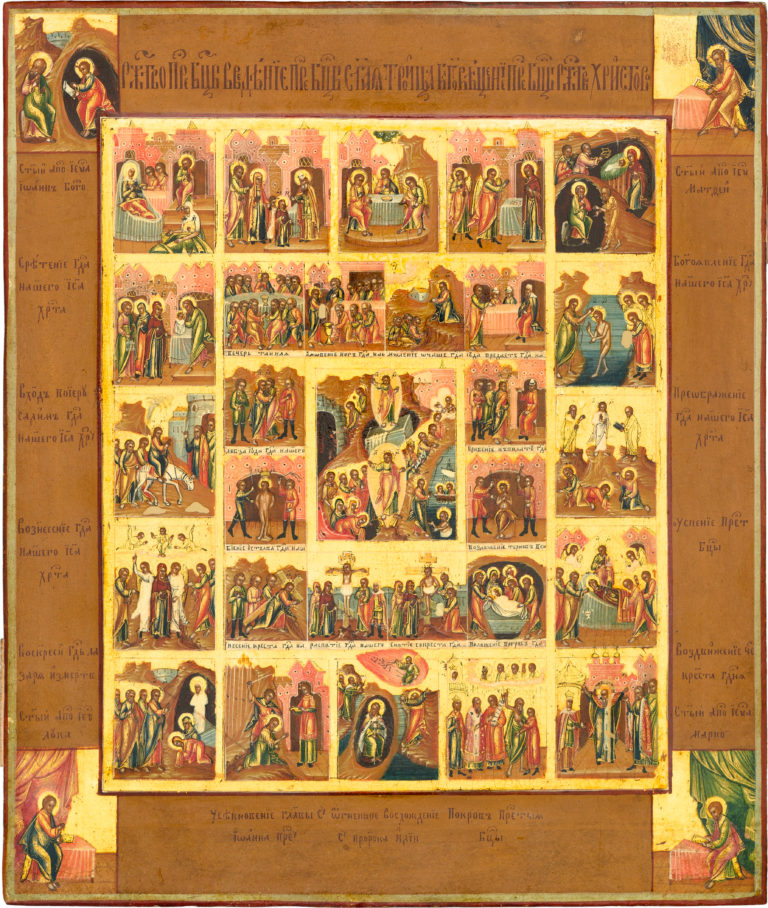The Resurrection – The Harrowing of Hades, with the Passions of Christ, the Four Evangelists, and Church Feasts in 28 border scenes
Antique Russian icon. Last quarter – end of the 19th century. Icon-painting villages of the Vladimir region.
Size: 31 х 26 х 2 сm
Wood (two panels), two incut profiled support boards, a shallow incut centerpiece, underlying layer of canvas is not visible, gesso, tempera, gold.
The author’s paintwork is in a good state. Slight chafing, remnants of darkened varnish (olifa) missed at restoration.
On the reverse of the religious icon panel, under the lower support board, there is a pencil inscription: “№ 10.”
Contact us

The Resurrection – The Harrowing of Hades, with the Passions of Christ, the Four Evangelists, and Church Feasts in 28 border scenes
Diagram of the border scenes:
The Feast cycle
- The Nativity of the Mother of God; 2.
- The Entrance of the Mother of God into the Temple; 3.
- The Old Testament Trinity; 4.
- The Annunciation; 5.
- The Nativity of Christ;
- Candlemas (The Meeting of Christ in the Temple);
- The Theophany (The Baptism of Christ);
- The Entrance into Jerusalem;
- The Transfiguration;
- The Ascension;
- The Dormition of the Mother of God;
- The Raising of Lazarus;
- The Beheading of John the Baptist;
- The Fiery Ascent of the Prophet Elias;
- The Pokrov (The Feast of the Protective veil of the Mother of God);
- The Elevation of the Holy Cross.
The Passion cycle
- The Last Supper;
- The Washing of the Feet;
- The Prayer in Gethsemane;
- Judas receives the 30 pieces of silver;
- The Betrayal of Judas and the Arrest of Christ;
- The Bringing of Christ before Pilate;
- The Flagellation of Christ;
- The Crown of Thorns;
- The Carrying of the Cross;
- The Crucifixion;
- The Taking Down from the Cross;
- The Entombment of Christ.
- The Evangelist John the Theologian;
- The Evangelist Matthew;
- The Evangelist Luke;
- The Evangelist Mark.
The given antique Russian icon is a traditional and highly popular in the 19th century variation of Eastern Orthodox icons depicting the Resurrection – the Harrowing of Hades with sixteen feasts. It is supplemented by the Passion cycle in ten border scenes that narrate the last days of Christ and the depictions of the four Evangelists placed in corner compositions that imitate the precious covers of the Altar Gospels. Hand-painted Orthodox icons with a complex composition that includes the Resurrection – the Harrowing of Hades and the main Feasts of liturgical year was widespread in the 19th century. The centerpiece of the given antique Russian icon bears the detailed version of the Resurrection – the Harrowing of Hades that became quite popular in later-period Russian iconography. Besides the image of Christ – Rising from the Tomb and taking Adam by the hand from the pits of Hades, the scene includes two processions – that of the angels marching towards the Gates of Hell and of the Pious walking towards Heaven and led by the Good Thief. In the lower left corner, we see the Gospel scene of the Revelation of Christ to the Apostles on the Sea of Galilee. All scenes are supplemented by corresponding inscriptions and are placed nearby, on the borders.
The hand-painted Orthodox icons of the Feasts were especially popular among the faithful, in many ways due to their practicality – a single religious icon with the main events of the liturgical year could be used as a miniature home iconostasis. In folk culture, they were also seen as a kind of agricultural calendar, with the cycle closely connected to the feasts of the liturgical year. Such hand-painted icons were soon produced on a mass scale, with iconographers ready to meet the tastes and financial abilities of any commissioner. Judging by the quick and draft-like manner of religious icon painting, which was developed by Palekh artists and taken up by iconographers of other Vladimir centers, as well as the monochromatic color pallet, one should come to the conclusion that the given antique Russian icon was painted at the end of the 19th century. The conventional character of such religious icon paintings and the standardized execution along with the use of the popular iconographic scheme make precise attribution of these pieces incredibly difficult. That is why it would be fair to state that the given antique Russian icon could have been painted either in Kholuy or in Mstyora, since both had workshops specializing in the mass production of religious icons, finishing up to 2-3 million pieces a year.